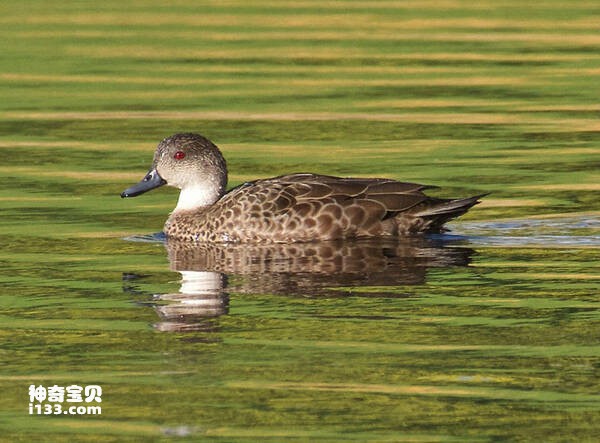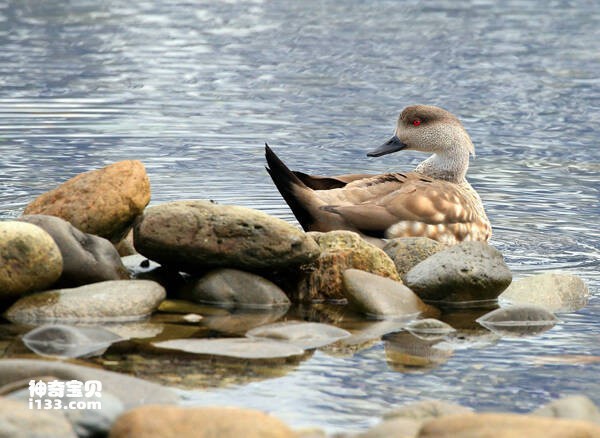Anas gracilis
IUCN
LCBasic Information
Scientific classification
- name:Anas gracilis
- Scientific Name:Anas gracilis,Grey Teal
- Outline:Waterfowl
- Family:
Vital signs
- length:37-47cm
- Weight:350-670g
- lifetime:No textual research information is available
Feature
Distribution and Habitat
It is found in Australia, Indonesia, New Caledonia, New Zealand, Papua New Guinea, and Vanuatu.
Probable extinction: Solomon Islands.
The breeding period mainly inhabits small and medium-sized lakes and various ponds with open, lush aquatic plants and little disturbance, while the non-breeding period inhabits large open lakes, rivers, estuaries, estuaries, bays, sandbanks, swamps and coastal zones.
Appearance
Grey ducks are 37-47 cm long with a 60-67 cm wingspan, males weigh 395-670 g and females weigh 350-602 g. It is a brown duck with grayish blue plumage in appearance. Both sexes are similar. The head is large, the neck is short and slender, and most of the main feathers have pale edges, which are fuzzy scales or mottled patterns. Plumage is mottled with dark brown and black markings. The wings are interspersed with white and have bronze-green wing mirrors, which are clearly visible during flight. Both males and females are grayish blue in colour, with light grey cheeks, chin and neck. Male ducks have a lighter and darker gray top than female ducks, and although both sexes are similar in appearance, the female is usually slightly smaller and slightly paler in plumage. The female duck has a chestnut green crown, a lighter neck, and a paler face. Young ducks have lighter plumage than adults, especially on their heads.
Iris is bright red, eyes long; The beak is bluish-gray.
Details
The Grey duck (Anas gracilis), also known as Grey Teal, was once classified as a subspecies of the Javanese grey duck, but was reclassified as a separate species by BirdLife International in 2008.

Gray ducks tend to live in wild grass in swampy areas near water. It mainly floats on the surface of the water and gets its food underwater, eating plants as the staple food and sometimes animal foods. Ducks have webbed toes, but rarely dive, swim with their tails out of the water, and are good at feeding, splashing and mating in the water. Like clean, often in the water and on the land preening carefully dressed. It mainly feeds on plant foods such as algae, aquatic plant leaves, seeds, grass seeds, grass leaves, etc., but also forages for rice and seedlings in farmlands, and occasionally eats small invertebrates such as mollusks, crustaceans and aquatic insects. Foraging occurs at dusk and early in the morning.

Grey duck breeding season depends on the region, usually between July and October, in New Zealand it is September and November. Nest in the grass on the shore of a lake, river, reservoir, pond, or in a reed or rushes. Nesting environments are extremely diverse. The nest is made of hay stalks, rushes and moss. A bowl-shaped nest is built from the stems of plants and grasses. The nest rises above the nearby water and is hidden among the water grasses. About 7-8 eggs are laid each time, and the incubation time is 25-31 days. The young birds leave the nest after 55 days and are usually hatched alone by the female ducks. After hatching, they are still cared for by the female ducks, and the ducklings follow the female ducks for food. By the eighth week, the duckling's eyes had turned red. A year later, they reach sexual maturity and are able to reproduce. The eggs are a bright yellowish color.
Listed on the International Union for Conservation of Nature (IUCN) 2013 Red List of Threatened Species ver 3.1 - Low Risk (LC).
Protect wild animals and eliminate wild meat.
Maintaining ecological balance is everyone's responsibility!








